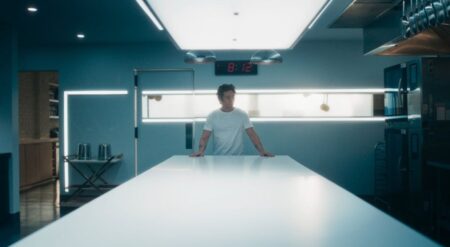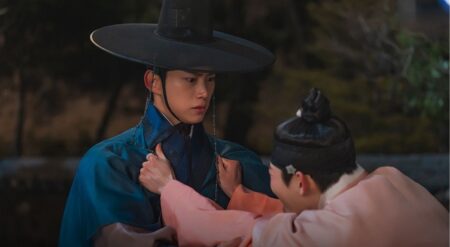
Copenhagen Cowboy is the newest project from Nicolas Winding Refn (NWR).The six-episode series is directed and written by Refn with the help of an all-female team of co-scriptwriters Sara Isabella Jønsson Vedde, Johanne Algren, and Mona Masri. Any fan of NWR will instantly recognize all the trademarks of his work from the crime-filled, seedy underbelly of Denmark to our stoic and cold protagonist Miu, played by Angela Bundalovic, exacting revenge on those who have harmed her. Viewers will be thrown into this neo-thriller with the full force of NWR at the most indulgent and creative point of his career.
The opening scenes of Copenhagen Cowboy sets the tone of the entire series. Frantic pig squeals fill the background, the setting is grey and dreary, and the only thing viewable is a woman being choked out. In a series of medium close-up shots, viewers never see this woman’s face, only her struggle as her legs buckle underneath her, the flexing of the man harming her, and the eventual cut to black. This power imbalance between men and women sits at the core of this show. Women face extreme violence from loved ones, protectors, family members, and anyone in between often in isolation from the rest of the world, and NWR and co want to do something about it. Our protagonist Miu is a silent, androgynous, track-suit-wearing harborer of vengeance among the streets of Copenhagen’s crime underbelly.
There isn’t much explanation about her origins outside of her processing a power to bring ‘luck’ into whoever owns her. She exists as a commodity. She’s bought, sold, and traded around to people wishing to exploit her for personal gain. While Refn could have chosen to make this story center around Miu’s inner dialogue and journey away from abusers, he keeps her story detached and dreamlike. There are plenty of scenes of Miu dripped in neon blues and reds as she infiltrates spaces belonging to human traffickers, mobsters, brothel owners, and hitmen. Some men don’t even have human dialogue and instead express themselves through pig squeals and cries, commentating on the selfishness and brutality of their nature throughout the show which feels so uncomfortable at times.
Long shots of isolated places showcase how disturbing and brutal the violence inflicted upon victims is. While some may find it gratuitous, it’s difficult to pry your eyes away from explicit and centered scenes of pain only because we know Miu, with her observant eyes and sulking body, is waiting to strike them down. In my favorite depiction of Miu as an angel of death, we sit with 3 minutes of silence from Miu as she sets a woman on fire for running a sex ring operating out of her house in episode two. NWR centers Miu from behind, with the brightness of a whole house engulfed in flames lighting the smallest semblance of a smile from our protagonist. She walks away, and credits roll with operatic music dominating the scene from composer Cliff Martinez and you have to just sit with the weight of the episode.

The rest of Copenhagen Cowboy is essentially the same. Miu finds herself at the doorsteps of some of the world’s most heinous monsters and how she deals with them. The lack of plot development and slow pacing can be detrimental if you intend to binge-watch Copenhagen Cowboy. However, the rest of the episodes are filled with enough striking and experimental camerawork that it mostly makes up for it. There are plenty of really stunning 360-angle shots that follow characters overhead as they walk back and forth during tense conversations, showing how NWR masters the art of tension.
There are beautiful set designs like in episode three that explores the decadence and beauty found in even the bleakest of places such as vintage, floral wallpaper, and frilly red pillows on a couch. Viewers see this as the camera backs away from an antagonist and fade into Miu’s face with dried flowers glued to her face and extravagant golden makeup and she contorts her body as if ready to attack. It’s indulgent, spanning over 3 minutes with no dialogue, but allows Copenhagen Cowboy to feel elevated, dreamy, and worthwhile. Not to mention, there is even a surprise cameo from one of my favorite video game designers whose inclusion was a delight.
This series is a slow burn that doesn’t reveal much of our protagonist’s backstory, motivations, or goals. Copenhagen Cowboy is a mesmerizing six-hour trek of exploring the necessity for violence and its consequences. Whether this is violence against women, crime bosses, sexual in nature, or violence for violence’s sake, there is an emotional resonance to the way NWR has viewers grapple. The message of vengeance and empowerment is explored through Miu’s descent into revenge but sits detached and reserved for the dark crevices of the viewer’s mind that can’t help but be mesmerized by the dreamlike sequences that Refn presents us with. Engrossing and hard to watch at times, Copenhagen Cowboy is an interesting meditation of the neo-thriller genre with just enough interesting commentary and stunning visuals that sits with you long after you’ve turned it off.
Copenhagen Cowboy is available now on, exclusively on Netflix.
Copenhagen Cowboy
-
Rating - 8/108/10
TL;DR
Copenhagen Cowboy is a mesmerizing six-hour trek of exploring the necessity for violence and its consequences.






